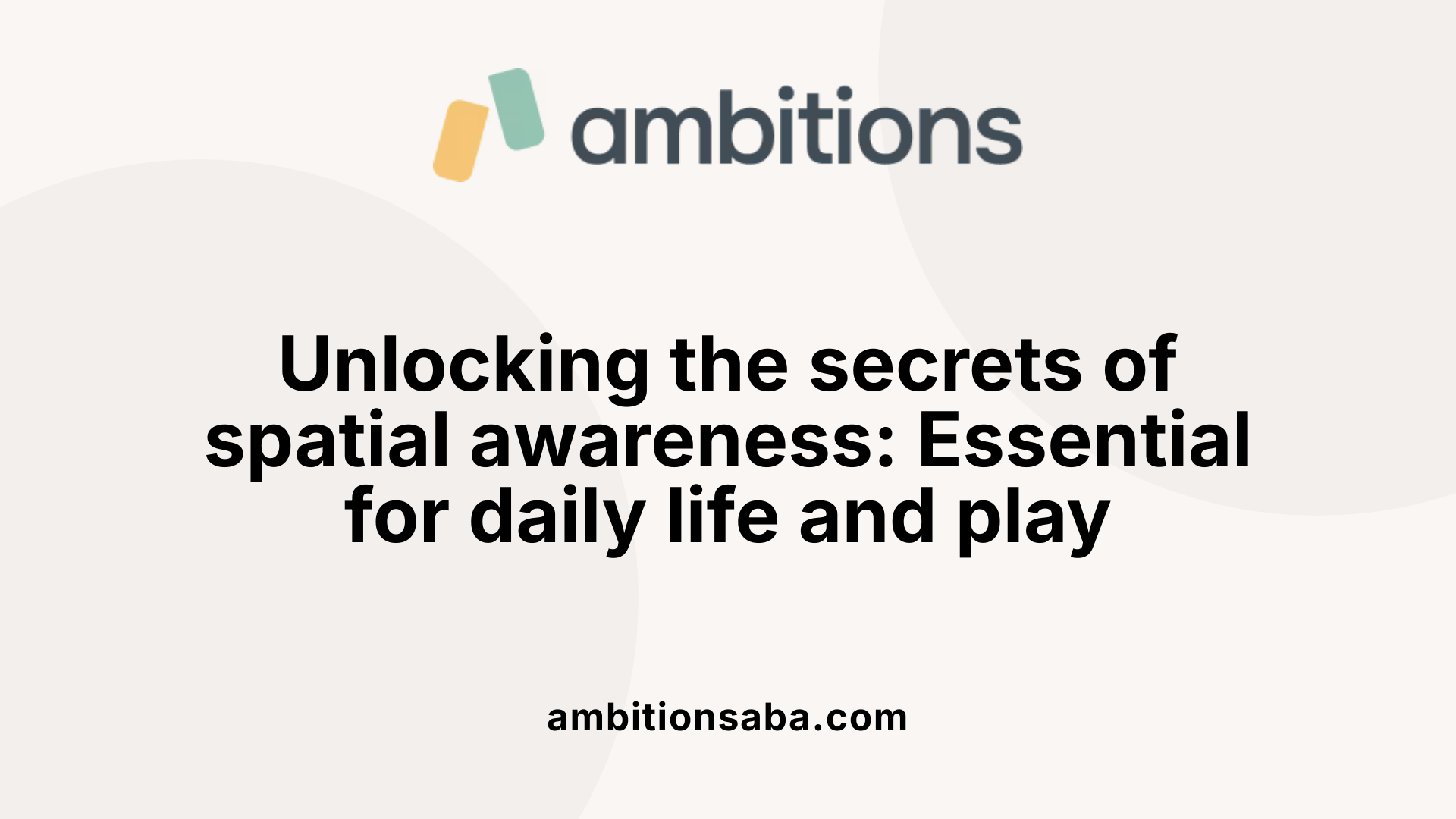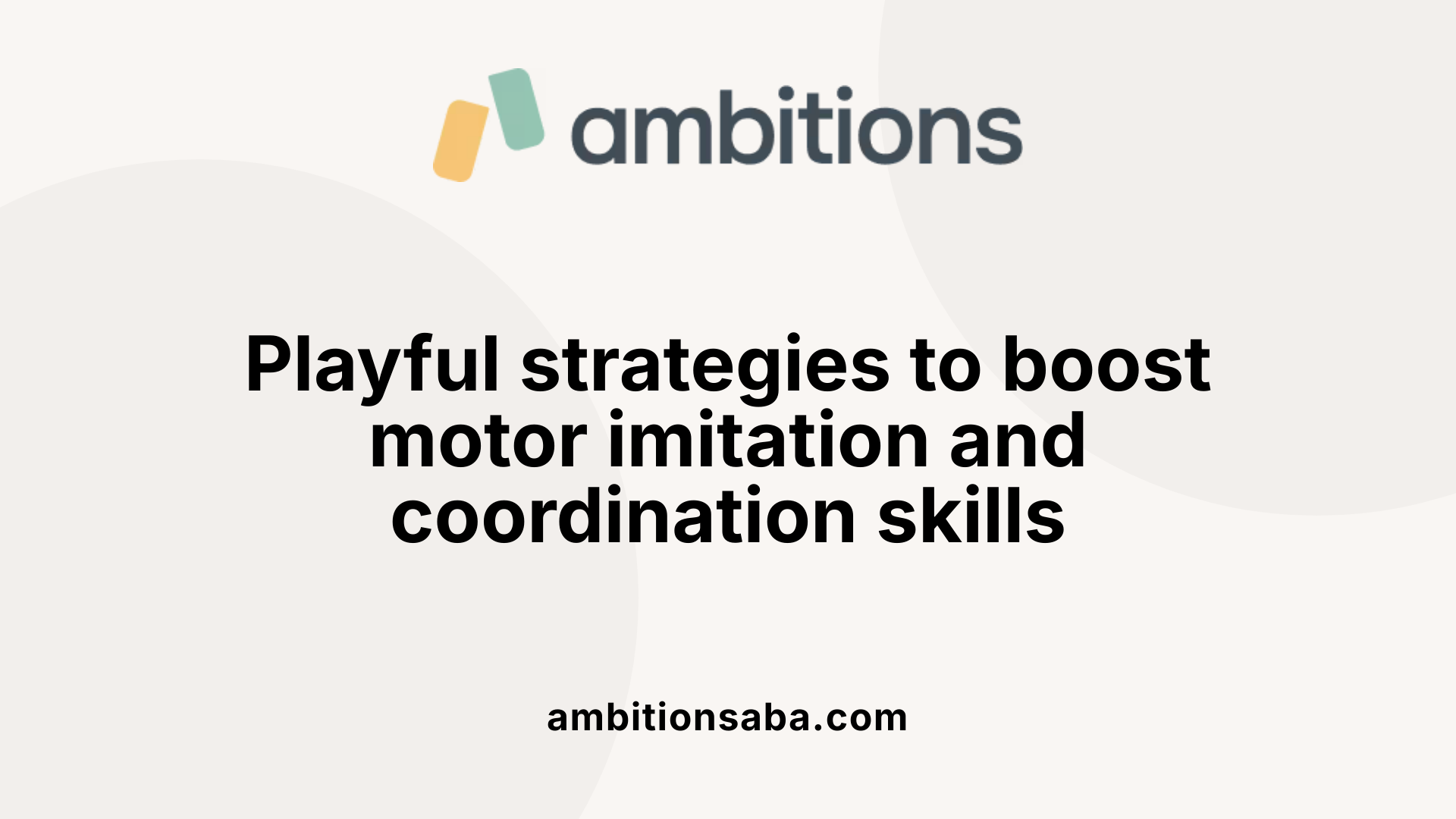Empowering Autistic Individuals for Self-Reliance
The Crucial Role of Play in Building Spatial Skills
Spatial awareness is fundamental for children's everyday interactions, enabling them to navigate their environment, engage in social activities, and learn new skills. For children on the autism spectrum, acquiring spatial awareness can be particularly challenging due to motor coordination difficulties and atypical sensory processing. Utilizing play as a medium not only fosters movement skills but also cultivates social abilities critical to comprehensive development. This article explores therapeutic approaches, including Applied Behavior Analysis and physical therapy, and the integration of play-based strategies that support spatial awareness and social skills in children with autism.
Understanding Spatial Awareness and Its Importance

What is Spatial Awareness?
Spatial awareness refers to the understanding of where objects are in space in relation to oneself and other objects. It involves recognizing distances, directions, and the physical positioning needed to move and interact effectively in the environment.
Why Is Spatial Awareness Important in Daily Activities and Play?
Good spatial awareness is essential for many everyday tasks, from navigating crowded hallways and playgrounds to participating in sports and play activities. It helps children coordinate their movements, maintain balance, and interact socially during group games and cooperative play.
Challenges Children with Autism May Face Related to Spatial Skills
Children with autism often experience difficulties with motor skills, which can impact their spatial awareness. Impairments in coordination and postural control may make it harder for them to judge distances and move confidently through their environments. These challenges can affect their ability to engage fully in play, social interactions, and routine activities.
Physical therapists play a vital role in assessing and improving these skills through tailored programs that focus on limb and body coordination, stability, and motor imitation. Enhancing spatial awareness not only supports physical movement but also promotes social participation and overall well-being for children with autism.
Applied Behavior Analysis (ABA) Therapy: Foundations and Benefits

What is Applied Behavior Analysis (ABA) therapy?
Applied Behavior Analysis (ABA) therapy is a research-backed approach that uses learning and motivation principles to help individuals, especially those with autism, develop skills and improve behaviors. It focuses on teaching communication, social interaction, daily living skills, and academics while minimizing negative behaviors. ABA uses techniques like positive reinforcement and analyzing behavior patterns, making it highly individualized based on continual assessment of progress. Trained professionals such as Board Certified Behavior Analysts (BCBAs) deliver ABA in homes, schools, and communities for people of all ages.
How does ABA therapy support development of spatial and social skills?
ABA therapy fosters social skills by providing structured learning and practice of social rules and communication, which many children with autism find challenging to acquire naturally. Through direct instruction, prompting, and repetition in real-life scenarios, ABA helps improve cooperation, understanding of social cues, and self-esteem. Additionally, by targeting motor imitation and coordination within its framework, ABA can enhance spatial skills important for movement and physical interaction with the environment. These combined benefits improve community participation and daily functioning.
How is ABA therapy customized to individual needs?
ABA therapy begins with comprehensive assessments that identify each individual's strengths, challenges, and goals. Based on these, therapists craft personalized treatment plans incorporating techniques like Discrete Trial Training (DTT) and Functional Communication Training (FCT) adapted to learning styles and situational needs. The therapy is flexible in setting and intensity, allowing sessions to take place at home, school, or community environments. Ongoing data collection supports dynamic adjustments to ensure progress is optimized for each person.
Who provides ABA therapy?
ABA services are delivered by specialized teams including Board Certified Behavior Analysts (BCBAs), Assistant Behavior Analysts (BCaBAs), and Registered Behavior Technicians (RBTs). BCBAs design and oversee individualized programs, while technicians implement therapies under supervision. These professionals often collaborate with families and educational staff to provide consistent support. Clinics and centers offering ABA ensure treatment is comprehensive, accessible, and tailored to each individual's developmental journey.
Physical Therapy’s Role in Enhancing Spatial Awareness Through Movement

What Motor Skill Challenges Do Children with Autism Face?
Children with autism spectrum disorder (ASD) often experience difficulties with motor skills. These challenges include limited coordination and difficulties with postural control, which can affect their ability to navigate and interact effectively within their environment. Such impairments can impact their participation in daily activities and play.
How Does Physical Therapy Address Coordination and Posture?
Physical therapists are trained experts in movement who assess and target these motor challenges. Through tailored physical therapy programs, children with ASD can develop better limb and body coordination, postural strength, and motor imitation skills. These foundational movement skills are critical for safe and confident navigation of spaces and for engaging in various play and social interactions.
Why Are Individualized Physical Therapy Plans Important?
Physical therapists evaluate each child’s unique needs by assessing postural strength, functional mobility, coordination, play skills, interests, and ability to switch activities. Based on this comprehensive evaluation, therapists design individualized treatment plans that focus on the child’s specific motor and sensory integration challenges. This personalized approach ensures that therapy targets the development of skills necessary for the child’s daily functioning and social engagement.
What Impact Does Physical Therapy Have on Daily Functioning and Play Skills?
By improving movement skills, physical therapy enhances children's ability to perform everyday tasks, such as navigating crowded hallways or playing with peers. Movement-based therapies—including games, sports, and creative activities—also promote social communication and cognitive function. Through these improvements, children with ASD gain greater confidence, participate more fully in their communities, and experience enhanced well-being.
Playing to Develop Motor Imitation and Coordination Skills

What Role Does Imitation Play in Learning Spatial and Social Skills?
Imitation is a foundational way children learn both spatial awareness and social interaction skills. For children with autism, imitating movements during play helps build coordination and body awareness needed for everyday tasks. Additionally, copying others' actions supports social learning by fostering connection and engagement.
How Does Physical Therapy Use Imitation in Play?
Physical therapists use imitation-focused activities to target motor skill challenges common in autism. These exercises often involve copying simple movements, gestures, or sequences that improve limb coordination and postural control. Therapists tailor these playful sessions to individual interests, encouraging repeated practice in a fun and supportive environment.
Examples of Play Activities Enhancing Coordination and Imitation
- Mirror Games: Child copies therapist’s hand, arm, or body movements.
- Action Songs: Engaging in songs with actions reinforces timing and coordination.
- Obstacle Courses: Children imitate specific motor tasks like jumping or crawling.
- Movement Stories: Children follow a story by acting out motions they observe.
These play activities develop essential motor imitation skills that translate into improved physical functioning and social interaction abilities for children with autism.
Integrating Social Skills Training with Spatial Awareness Development

What Are Social Skills and Why Do They Matter for Autism?
Social skills involve the unwritten rules and abilities that guide how we interact with others. While most learn these naturally, individuals with autism often require explicit support to develop them. Enhancing social skills helps promote better community participation, happiness, and stronger friendships for people with autism.
How Are Social Skills Groups Structured and What Benefits Do They Provide?
Social skills groups, led by professionals like special education teachers and speech pathologists, offer structured settings where individuals with autism can practice and generalize social skills. These groups simplify abstract concepts, encourage cooperation, and provide varied learning opportunities that foster self-awareness and self-esteem. Activities often focus on real-life social scenarios to improve practical communication.
How Does Spatial Awareness Connect with Social Interaction?
Spatial awareness—the ability to understand and navigate physical space—is deeply connected to social skills. For children with autism, motor impairments such as limited coordination can affect their ability to engage comfortably in social situations. Physical therapists work to improve posture, coordination, and motor imitation, which enhance the ability to interact in group settings and respond effectively in play and communication.
What Social Skills Activities Incorporate Spatial Concepts?
Effective social skills training often includes movement-based activities such as group games, sports, and creative movement therapies. These activities simultaneously develop motor skills and offer opportunities to practice turn-taking, personal space boundaries, and nonverbal communication. For example, a group game requiring participants to navigate shared space while communicating encourages both social and spatial skill development.
By integrating social skills instruction with spatial awareness development, programs support holistic growth and promote better daily functioning for individuals with autism.
Movement-Based Therapies: Creative Approaches for Cognitive and Social Gains
What Types of Movement-Based Therapies Are Used for Autism?
Movement-based therapies for children with autism spectrum disorder (ASD) often include creative movement, sports, and aquatic exercises. These varied activities are designed to engage different senses and motor skills, providing multiple avenues for children to improve coordination, balance, and body awareness.
Creative movement therapy uses dance and expressive motion to encourage children to explore physical expression, while sports offer structured opportunities for teamwork and social interaction. Aquatic therapy takes advantage of the water’s buoyancy and resistance to support movement and muscle development in a gentle environment.
How Does Movement Enhance Social Communication and Cognition?
Participation in these movement-based activities supports more than just physical development. They also promote social communication by encouraging turn-taking, cooperation, and nonverbal interaction among peers. Cognitive gains arise as children learn to follow instructions, react to changing situations, and develop problem-solving skills during dynamic activities.
Imitation of movement patterns, a focus in physical therapy, plays an essential role in fostering social learning. By improving motor skills, children with ASD become more comfortable engaging in social play and can better interpret social cues.
What Are the Therapeutic Benefits for Daily Skills and Overall Well-Being?
Physical therapists tailor programs to enhance limb and body coordination, stability, and functional mobility, which are crucial for everyday tasks like dressing, playing, and navigating environments such as school playgrounds.
Movement-based therapies also improve self-confidence and reduce sensory challenges, contributing to greater participation in community and social activities. For adults with ASD, physiotherapy supports physical fitness and social functioning, aiding employment and daily living.
Altogether, these creative movement approaches offer a holistic path to improving both the physical and social aspects of life for people with autism.
Physical Therapy Across Different Life Stages to Support Spatial Awareness
Early Childhood Physical Therapy Focusing on Movement and Play
Physical therapy in early childhood, particularly from birth to age 3, plays a vital role in helping children with autism develop age-appropriate movement skills and imitation abilities. These motor skills are essential for social interaction and learning through play, laying a foundation for future social and cognitive growth. Therapists focus on enhancing postural strength and coordination, which contribute to a child’s ability to engage with their environment and peers.
Support During School Years for Navigation and Social Skills
During the school years, from ages 3 to 18, physical therapy supports children with ASD by addressing challenges such as navigating crowded hallways, playgrounds, and other school environments. Physical therapists employ movement activities, games, and sports to improve motor skills while also fostering social skills. Through such movement-based therapies, children enhance their coordination, stability, and motor imitation—all critical to participating confidently in school and social settings.
Physical Therapy Benefits for Adults with Autism, Including Physical Fitness and Employment Support
Adults with autism also benefit from physical therapy through personalized exercise programs designed to improve movement efficiency, physical fitness, and social functioning. Such interventions help support independence in daily activities and employment by improving coordination and general physical well-being. This ongoing support facilitates better community participation and improved quality of life.
By adjusting physical therapy approaches across different life stages, therapists help individuals with autism develop and maintain spatial awareness, motor coordination, and social integration throughout their lifespan.
Creating Supportive Environments for Practicing Spatial and Social Skills
Why Are Realistic Settings Important for Practice?
Practicing social and spatial skills in realistic environments is crucial for children and adults with autism to successfully apply what they learn in daily life. Settings that mirror natural community environments—like playgrounds, classrooms, or group activities—help individuals generalize social skills, making interactions smoother and more natural outside therapy sessions.
How Can Cooperation and Communication Be Encouraged Through Play?
Play offers a natural pathway for developing social skills. Encouraging cooperative play helps individuals with autism learn to share, take turns, and communicate needs and feelings. Guided play activities led by specialists provide opportunities to practice these interactions in a structured, supportive context, fostering teamwork and understanding.
How Can Environments Be Adapted To Sensory Needs and Promote Self-Esteem?
Since sensory processing sensitivities are common in autism, adapting environments is essential. This may include reducing loud noises, limiting visual distractions, or providing calming spaces. Such adaptations help reduce anxiety and sensory overload, allowing participants to focus on interaction. Additionally, structured settings that break down complex social concepts and provide positive reinforcement help build confidence and self-esteem, making social engagement more rewarding and less intimidating.
Measuring Progress and Adjusting Therapeutic Plans
How is progress monitored in interventions for autism?
Ongoing assessment and data collection play a pivotal role in autism therapy. Professionals continuously observe and measure a child's or adult's development in social skills, motor coordination, and communication abilities. This ongoing monitoring helps identify areas of improvement as well as challenges that need additional support.
How are interventions adapted based on individual progress?
Therapeutic plans such as Applied Behavior Analysis (ABA) and physical therapy are flexible and individualized. As progress is tracked, specialists adjust goals, methods, and intensity. For example, if a person shows improvement in motor coordination, therapy may introduce more complex movement activities or focus more on social interaction skills. Similarly, if social skill groups reveal difficulties in certain areas, the curriculum can be tailored to break down those skills into simpler steps.
What role do families and professionals play in adjusting therapies?
A collaborative approach is essential for effective therapy. Families provide valuable insights about daily activities and challenges, while professionals bring expertise in intervention strategies. Regular communication between parents, therapists, and educators ensures that therapeutic goals remain relevant and achievable. This teamwork also supports consistency across home, school, and community settings, fostering more meaningful progress.
The Path Forward: Play as a Bridge to Spatial and Social Mastery
Teaching spatial awareness through play offers a dynamic and effective pathway for children with autism to develop crucial motor, social, and communication skills. By integrating Applied Behavior Analysis principles with physical therapy interventions, and by embedding these therapies within playful, supportive environments, practitioners can create individualized programs that foster independence and happiness. Encouraging movement, imitation, and interaction in realistic settings not only enhances spatial understanding but also builds confidence and social competence. Continuous monitoring and collaboration among therapists, families, and educators ensure that interventions evolve to meet each child's unique growth trajectory, unlocking their full potential through the power of play.

